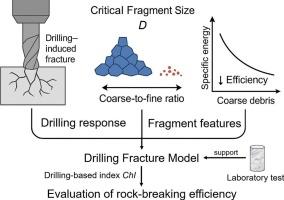Modelling of critical fragment size and rock breaking efficiency evaluation in drilling process
IF 4.6
2区 工程技术
Q2 ENGINEERING, CHEMICAL
引用次数: 0
Abstract
Understanding the rock fracture behaviors during drilling is crucial to evaluating the breaking efficiency. Since fragment generation is intrinsically related to drilling mechanism, the fragment size distribution is determined by the drilling response. In this paper, an analytical model is established to describe the fragment generation, from which a function of the cutting force incorporating critical fragment size, rock strength and drilling parameters is derived. A collapse index is defined to evaluate drilling efficiency. Digital drilling tests, coupled with laboratory tests, were conducted on four rock types to investigate the effect of confining pressures and lithologies on the fragment characteristics and drilling response. Results shown that the effect of confining pressure on rock fragmentation behavior during drilling becomes more significant, manifested as a segmented drilling response. The distribution characteristics of rock fragment was examined by the Rosin-Rammler (R-R) function to determine the critical size in drilling process. The fracture model prediction results are in good agreement with the experimental results. The proposed drilling efficiency index decreases with increasing confining pressure, due to the enhancing effect of confining pressure on rock toughness. A comparison among drilling efficiency, production capacity and specific cutting energy confirmed its practical applicability. The innovation of this study is to provide a method to evaluate rock breaking efficiency and to determine fragment size by considering drilling response.

钻井过程临界破岩尺寸建模及破岩效率评价
了解钻井过程中岩石的破裂行为是评价破岩效率的关键。由于破片的产生与钻井机制有着内在的联系,因此破片的大小分布由钻井响应决定。本文建立了一个描述破片生成的解析模型,并由此导出了包含临界破片尺寸、岩石强度和钻孔参数的切削力函数。定义了陷落指数来评价钻井效率。为了研究围压和岩性对破片特征和钻井响应的影响,对四种岩石类型进行了数字钻井试验和室内试验。结果表明:围压对钻井过程中岩石破碎行为的影响更为显著,表现为分段钻井响应;利用松香-拉姆勒函数(Rosin-Rammler, R-R)分析了岩屑的分布特征,确定了钻孔过程中岩屑的临界尺寸。裂缝模型预测结果与实验结果吻合较好。由于围压对岩石韧性的增强作用,钻井效率指数随围压的增加而降低。通过对钻进效率、生产能力和切削比能的比较,证实了该方法的实用性。本研究的创新之处在于提供了一种通过考虑钻井响应来评估破岩效率和确定破岩大小的方法。
本文章由计算机程序翻译,如有差异,请以英文原文为准。
求助全文
约1分钟内获得全文
求助全文
来源期刊

Powder Technology
工程技术-工程:化工
CiteScore
9.90
自引率
15.40%
发文量
1047
审稿时长
46 days
期刊介绍:
Powder Technology is an International Journal on the Science and Technology of Wet and Dry Particulate Systems. Powder Technology publishes papers on all aspects of the formation of particles and their characterisation and on the study of systems containing particulate solids. No limitation is imposed on the size of the particles, which may range from nanometre scale, as in pigments or aerosols, to that of mined or quarried materials. The following list of topics is not intended to be comprehensive, but rather to indicate typical subjects which fall within the scope of the journal's interests:
Formation and synthesis of particles by precipitation and other methods.
Modification of particles by agglomeration, coating, comminution and attrition.
Characterisation of the size, shape, surface area, pore structure and strength of particles and agglomerates (including the origins and effects of inter particle forces).
Packing, failure, flow and permeability of assemblies of particles.
Particle-particle interactions and suspension rheology.
Handling and processing operations such as slurry flow, fluidization, pneumatic conveying.
Interactions between particles and their environment, including delivery of particulate products to the body.
Applications of particle technology in production of pharmaceuticals, chemicals, foods, pigments, structural, and functional materials and in environmental and energy related matters.
For materials-oriented contributions we are looking for articles revealing the effect of particle/powder characteristics (size, morphology and composition, in that order) on material performance or functionality and, ideally, comparison to any industrial standard.
 求助内容:
求助内容: 应助结果提醒方式:
应助结果提醒方式:


